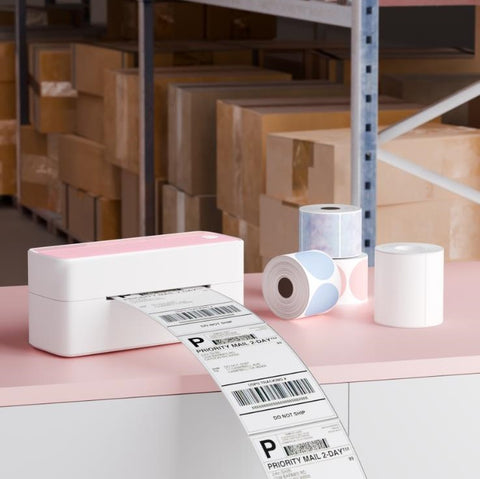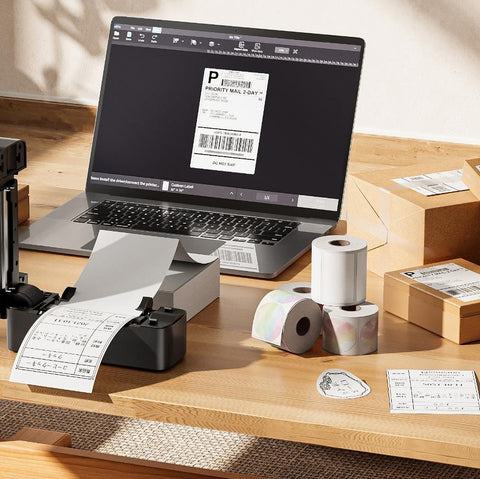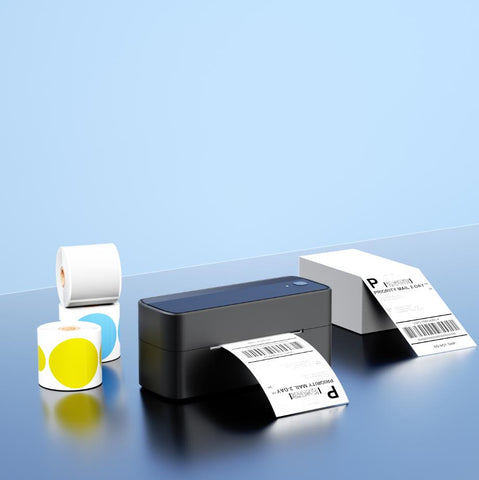Thermal labels play a crucial role in various industries, from retail to manufacturing, healthcare to logistics. They help convey information, streamline operations, and enhance brand visibility. When it comes to label formats, two popular options are fan fold labels and roll labels. Each has its own set of advantages and considerations, and choosing between them is an important decision for businesses. In this comprehensive guide, we'll delve into the key differences, benefits, and factors to consider when choosing between fan fold labels and roll labels.
What is roll label?
A thermal roll label, relative to fan-fold labels, is a type of label supply that comes in the form of a roll rather than a fan-folded stack. While both types of labels serve similar purposes, they differ in their form factor and how they are loaded into the printer.
In a thermal roll label, the labels are wound around a core, forming a cylindrical roll. This roll is then loaded into a compatible thermal printer, where the labels are fed through a mechanism for printing. Thermal label rolls are often used in situations where a continuous supply of labels is needed, such as in high-volume printing environments or automated labeling systems.

What is fan-fold label?
Fan-fold labels are a type of label supply that is folded in a zigzag or accordion-like pattern, resembling a fan when viewed from the side. They are typically connected by perforations, allowing them to be easily separated when needed.
In contrast to roll labels, which are wound around a core and fed through the printer in a continuous roll format, fan-fold labels are stacked together compactly. They are loaded into the printer by unfolding the stack and feeding the labels through a suitable mechanism. While they do require space on a desk or surface, fan-fold labels are commonly chosen for their compatibility with specific printers and ease of handling. They find frequent use in applications such as shipping labels, barcode labels, and product labeling.

What are differences between label roll and fan-fold label?
Roll labels and fan-fold labels are two common types of label supplies used in various industries. Label rolls are characterized by their cylindrical form, wound around a core, making them compatible with thermal printers that can feed labels internally. This feature saves space, making roll labels ideal for businesses with limited office space. However, a common issue with roll labels is that the labels often come out curled, requiring flattening before use. Additionally, roll labels need to be restocked frequently due to their continuous feeding mechanism.
In contrast, fan-fold labels are folded in a zigzag or accordion-like pattern, resembling a fan when viewed from the side. They do not come out curled, ready for immediate use, which can be advantageous for some applications. Fan-fold labels are less prone to frequent restocking compared to roll labels. However, they need to be fed outside the thermal printer, making them more susceptible to dust accumulation. Moreover, fan-fold labels may stick together, requiring careful separation before use. These differences between roll labels and fan-fold labels help businesses choose the most suitable label format based on factors such as space availability, frequency of use, and environmental conditions.
What are roll label and fan-fold label used for?
Roll labels and fan-fold labels, typically sized at 4x6 inches, are commonly used for printing shipping labels or logistics documents, such as shipping labels, packing slips, or invoices, in various industries. These labels are particularly popular in e-commerce, retail, manufacturing, and logistics sectors for their versatility and compatibility with thermal printing technology.
Both roll labels and fan-fold labels are ideal for printing shipping labels due to their thermal printing capabilities, which produce high-quality, durable labels without the need for ink or toner. The 4x6-inches shipping label size is a standard dimension often required by shipping carriers and logistics companies for labeling packages and shipments accurately.
Whether it's for printing shipping labels for packages, organizing inventory, or managing logistics documentation, roll labels, and fan-fold labels are essential tools for businesses seeking efficient and reliable labeling solutions in their operations.

What type of printer can I use to print roll label and fan-fold label?
Both thermal roll labels and fan-fold labels are compatible with shipping label printers. These printers utilize heat to create images or text on the labels without the need for ink or toner, resulting in cost-effective and high-quality printing solutions.
The following types of thermal printers can typically be used to print thermal roll labels and fan-fold labels:
Direct Thermal Printers: These printers create images by applying heat directly to the thermal label or paper, activating the heat-sensitive coating. Direct thermal printers are commonly used for printing shipping labels, barcode labels, receipts, and other short-term applications.
Thermal Transfer Printers: Unlike direct thermal printers, thermal transfer printers use a ribbon to transfer ink onto the label material, resulting in more durable and long-lasting labels. These printers are suitable for applications requiring labels that are resistant to heat, moisture, and chemicals.
See also: What Are the Differences Between Direct Thermal and Thermal Transfer?
Both direct thermal and thermal transfer printers come in various sizes and configurations, including desktop, industrial, and mobile/portable models, to suit different printing needs and volumes. When selecting a printer for thermal roll labels or fan-fold labels, it's essential to consider factors such as print speed, print resolution, connectivity options, and compatibility with label sizes and formats. Additionally, ensure that the chosen printer supports the specific type of labels (rolls or fan-fold) you intend to use.
Indeed, while both direct thermal and thermal transfer printers can handle thermal roll labels and fan-fold labels, direct thermal printers are often preferred for several reasons:
- Simplicity: Direct thermal printers have fewer moving parts compared to thermal transfer printers because they don't require a ribbon. This simplicity can lead to lower maintenance costs and fewer potential points of failure.
- Cost-effectiveness: Direct thermal printing eliminates the need for ink ribbons, reducing ongoing consumable costs. This makes direct thermal printing particularly cost-effective for applications with moderate to high label printing volumes.
- Ease of Use: Direct thermal printers are often easier to set up and operate, making them suitable for environments where simplicity and efficiency are priorities. They typically have straightforward loading mechanisms for roll labels or fan-fold labels.
- Speed: Direct thermal printers can print labels at high speeds, making them suitable for applications requiring rapid label production, such as shipping and logistics.
- Environmental Considerations: While both direct thermal and thermal transfer printing are environmentally friendly compared to traditional printing methods like inkjet or laser printing, direct thermal printing eliminates the need for ink ribbons, further reducing waste.
Overall, direct thermal printers offer a compelling choice for businesses seeking efficient, cost-effective, and environmentally friendly label printing solutions with thermal roll labels or fan-fold labels.

Summary
The choice between fan-fold labels and roll labels depends on various factors such as printing equipment, label application process, storage space, and cost considerations. Both options offer unique advantages and considerations, so it's essential to assess your specific needs and requirements before making a decision. Whether you prioritize cost-effectiveness, storage efficiency, or printing flexibility, selecting the right label format is crucial for optimizing your labeling operations and enhancing brand visibility.










